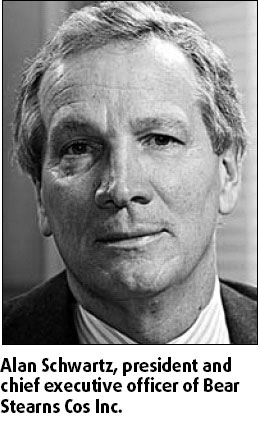How Bear Stearns crisis unfolded
Alan Schwartz wasn't supposed to be running Bear Stearns Cos, and now he is presiding over the 85-year-old securities firm's sale.
An investment banker for much of his 32 years at Bear Stearns, Schwartz is ending it with a last deal: The purchase of the firm by JPMorgan Chase & Co for less than 7 percent of its March 14 value.
The Federal Reserve said March 14 it would provide emergency funding to Bear Stearns through JPMorgan, capping a week in which Schwartz first denied, then acknowledged, the firm was running short of cash. Shares of New York-based Bear Stearns fell $27, or 47 percent, to $30 on March 14, the lowest since 1998.
The crucial period came over 24 hours starting March 13, when Schwartz, 57, realized withdrawals by customers and lenders had escalated so rapidly they would wipe out the firm's $17 billion in cash, and culminated in a 5 am conference call the next day among regulators including Fed Chairman Ben Bernanke and Treasury Secretary Hank Paulson.

The Fed acted to forestall a market panic as credit losses by banks and brokers reached $195 billion and stocks plunged for a third day last week.
It was bond chief Warren Spector who pushed the firm into new securities offering higher returns for higher risk. Bets on mortgage bonds helped the bank earn $2.1 billion in 2006 on revenue of $9.2 billion. Its shares gained 41 percent in 2006.
Bear Stearns' financial troubles began in July, when two hedge funds that invested in securities tied to mortgages collapsed. The firm had to bail out the funds and take possession of many of the instruments.
In August, Cayne ousted Spector, who was allowed to keep stock and option awards worth about $23 million.
Three months later, Cayne, 74, sent a memo to employees saying he remained "intensely focused" on the firm after the Wall Street Journal reported he spent 10 of 21 working days outside the office in July as the two funds collapsed.
Schwartz replaced James Cayne as CEO on Jan 8 after the firm reported an $854 million fourth-quarter loss, the first quarterly deficit in its history. Cayne remains non-executive chairman.
With quarterly results of Bear and other Wall Street securities firms due this week, investors began to speculate more losses were coming.
The stock plummeted 11 percent March 10 on concern the firm was running short of funds.
Schwartz said in a statement that "there is absolutely no truth to the rumors of liquidity problems".
On March 11, and increasingly through the week, lenders and customers began to withdraw funds, according to a timeline published by the US Securities and Exchange Commission.
Bear Stearns was handling the withdrawals until March 13, the day the Journal said trading partners were reluctant to engage in long-term transactions, Schwartz told analysts on a conference call.
As withdrawals escalated, Bear began talking to JPMorgan, the clearing bank for its trades, about "providing a liquidity facility that would allow us to achieve the objective of calming down the marketplace", he said.
Fed officials were told of the situation's severity at 7:30 pm that day, and Fed examiners spent the night at Bear, according to people with knowledge of the matter. At the dawn conference call the next day, Bernanke, Paulson, New York Fed President Timothy Geithner, Fed Vice-Chairman Donald Kohn and Treasury Undersecretary Robert Steel for two hours debated extending the loan and decided it was necessary to avoid panic, the people said.
Paulson phoned to brief President George W. Bush, who was due to speak on the economy in New York. The Fed invoked a law it hasn't used since the 1960s to lend to a private corporation.
At 9 am, Geithner, Paulson, Erik Serri, the SEC's head of market regulation, Schwartz and JPMorgan CEO Jamie Dimon had a conference call with the Bank of New York and the heads of the primary dealers who trade with the Fed, according to the people with knowledge of the events. Paulson argued on the call that they all had a stake in keeping the financial system working smoothly, they said.
The Fed agreed to provide financing to Bear through JPMorgan for up to 28 days. It became clear over the weekend that the window of survival was even shorter. Schwartz was unlikely to revive the firm without convincing a buyer to take on its assets, said Brad Hintz, an analyst at Sanford C. Bernstein & Co in New York, before the deal was announced.
Agencies
(China Daily 03/18/2008 page17)












